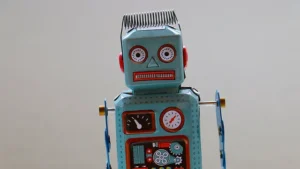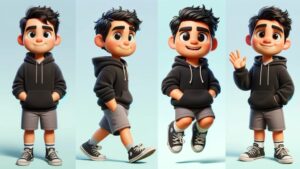Artificial intelligence (AI) has made it possible for individuals with no musical talent to create stunning soundtracks for their social media posts, YouTube videos, and more. AI music generators are the hottest trend in AI right now, and it’s easy to see why. In this post, we’ll explain how generative AI works and how to generate AI music in a few steps.
The post will cover what AI music is, how it works, the benefits of using AI to generate music, and how to generate AI music. It will also explore some of the best AI music generators with voice and the future of AI music. By the end of the article, readers will have a clear understanding of how to create their own AI music tracks.
What is AI Music?
AI music is a form of generative AI that uses text prompts to generate musical tracks with different instruments, styles, and genres. It can also create compositions, modify existing music, or even generate vocals. Since the introduction of generative AI in 2015, different forms of artificial intelligence have emerged, including text-to-speech, natural language processing, and AI art generators. AI music has become increasingly popular in recent years due to its ability to create original music that is both unique and high-quality. Here is a short clip generated using Mubert, an AI music generator, using a brief text prompt.
How Does AI Music Work?
Like other forms of generative AI, AI music is based on deep-learning computer systems trained on massive amounts of musical data, such as songs, artists, and genres. These models can be based on recurrent neural networks (RNNs), generative adversarial networks (GANs), generative pre-trained transformers (GPT), or music information retrieval (MIR).
Recurrent Neural Networks
Recurrent Neural Networks (RNNs) are specialized neural networks that are great at understanding and processing data that comes in sequences, like sentences or time series. In simple terms, RNNs can predict outcomes in sequential data, which other AI algorithms struggle with. RNNs are particularly useful when dealing with data that follows a specific order or pattern, like music. RNNs are trained on large amounts of musical data and can be used to generate new music. They can be used to create melodies, harmonies, and rhythms based on the input data.
Generative Adversarial Networks
Generative Adversarial Networks (GANs) are primarily used for generating images, avatars, and other forms of AI, but they are also used to create AI music. GANs are comprised of two parts, a generator and a discriminator. GANs use these two neural networks to train systems to generate music. The discriminator is used to determine whether the input given is real or fake. The generator’s job is to try and fool the discriminator. Throughout thousands of training sessions, the generator will improve the results to the point where the discriminator can’t tell the difference. In music generation, this is a relatively challenging task. However, with the help of GANs, AI music can be generated with a high degree of accuracy.
Generative Pre-Trained Transformers
Generative pre-trained transformers are advanced language models that combine the power of transformers and pre-training. They learn from large amounts of data and can generate human-like text, images, and music. A GPT model based on music works by inputting a seed sequence that allows the model to predict the next note or chords in a song. GPTs can be trained on large amounts of musical data to create original music. They can create music in various genres, styles, and moods.
Music Information Retrieval (MIR)
Music Information Retrieval (MIR) is a field of study and development of techniques that enable computers to analyze, understand, and extract information from musical data. MIR works as a bridge between music and machine by using AI algorithms to process and interpret musical content. Machines can learn to classify music into genres, moods, or other classes based on audio features and metadata. Machines then use this information to generate original music based on the tempo, rhythmic patterns, harmonic structure, or chords, to name a few. MIR is particularly useful for creating music that is tailored to a specific audience or purpose.
In summary, AI music is a fascinating field that combines the power of deep learning, neural networks, and music. AI music can be generated using various techniques, including RNNs, GANs, GPTs, and MIR. Each method has its strengths and weaknesses, and the choice of method depends on the desired outcome. AI music has the potential to revolutionize the music industry by creating new forms of music that were previously impossible to create.
Benefits of Using AI to Generate Music
One of the biggest benefits of using AI music generators is their ease of use. With platforms like Mubert, users can input a brief description of the music they want to create, and within minutes, they will have a background track ready for use in their creative projects. This eliminates the need for extensive knowledge in music editing programs and allows anyone to become a masterful music artist.
Another advantage of AI music generators is their affordability. Most platforms offer free usage or cost no more than $20-30 a month, making them accessible even to those on a budget. Additionally, these tools provide a high level of customization. For instance, Landr offers downloadable apps that allow users to edit their music clips, add vocals, and blend in other tracks.
Finally, AI music generators offer license-free music production, meaning users can use the generated music anywhere without the hassle of contracts or legal agreements. This makes it easier for artists to create and use music without worrying about copyright issues.
Overall, AI music generators provide an affordable, easy-to-use, and customizable solution for music production, making them an attractive option for both amateur and professional musicians.
How to Generate AI Music
1. Sign Up For a Free Account
To begin the process, users need to sign up for a free account on the Mubert website. They can do so by clicking the “sign up” button and then choosing to log in with Google or Facebook or creating a new account using their email address and a password. After completing the sign-up process, Mubert will send a verification code via email for the user to enter and finalize the account creation.
2. Explore the Mubert Interface
Once the account is set up, users will have access to the intuitive Mubert interface. They can easily generate a new track, search by a reference URL, or enter a text prompt to create music. In addition, users have the option to choose from different genres, moods, and activities to tailor the music to their preferences. After inputting the necessary details, they can click the “Generate track” button to create the music.
3. Generate Your First AI Music Track
Users can generate their first AI music track by entering a text prompt and setting the desired duration for the track. After clicking the “generate track” button, the track will be visible for preview. Users can then choose to download the track and have the option to regenerate it if they are not satisfied with the results. Additionally, users can select the type of track, such as mix, loop, or jingle, based on their preferences.
4. Download Your Track
After creating and finalizing the track, users can download it for use in their projects. For free account users, it is important to attribute the content to Mubert when downloading. Alternatively, users can opt for a paid subscription to gain more flexibility in using their created tracks. However, regardless of the subscription, users cannot upload their creation to platforms like Spotify or Apple Music. They can, however, sell their track on the Mubert Studio.
5. List Your Track on Mubert Studio
One of the notable features of Mubert is the ability to generate passive income from the AI music tracks created. Users can list their tracks on Mubert Studio, which allows them to contribute and earn from their creations. By setting up an account and creating a stream, users can list their tracks, providing details such as the track name, key, scale, BPM, and activity. Additionally, users can add information about the mood, weather, genre, and tags to make their track easily discoverable by other users.
AI Music Generators with Voice
If you want to create music with vocals, there are a few AI tools you can use. Some of these tools allow you to create voiceovers or other natural-sounding speech, while others are specifically designed for singing voices. Here are three AI music generators with voice that you can use to create your own music:
Landr
Landr is a popular AI audio tool that allows you to create, edit, and distribute your music through an intuitive interface. It is a top-rated platform used by recording artists such as Lady Gaga and Post Malone. With Landr, you can mix and master your creations with ease. The platform offers a variety of features, including an AI-powered mastering tool that can help you improve the quality of your music. Landr is available for a low monthly price of $12.
Pricing: $12 per month.
Synthesizer V
Dreamsonics Synthesizer V is another excellent program if you want to create music complete with vocals. You can make tracks with a text prompt and apply your favorite AI voice. The app is free to download and comes with sample AI voices to play around with. If you decide it’s the platform for you, there are a variety of AI voices you can purchase. With the free version, you can create up to 3 tracks, which gives you plenty of time to decide if it’s right for your needs.
Pricing: Free, with packages starting at $79.
Revocalize
Revocalize is a unique tool that allows you to record your voice and apply different tones, effects, and pitches. It works differently than the other tools on our list. Through the magic of AI, Revocalize alters and enhances your voice and allows you to add different tones, effects, and pitches. Even better, they use a proprietary algorithm, a voice identity (UVI) singing model, which protects and secures your voice. Copyright protection gives you the right to use it as you see fit. This is an excellent feature considering all the copyright issues other AI platforms face. However, if you want access to the free version of Revocalize, you must sign up and be on a waitlist.
Pricing: Free, with monthly plans starting at $9.
The Future of AI Music
The future of AI-generated music is promising. Although some may view it as a threat to the job market or human creativity, legal protections can be put in place to safeguard the rights of both AI creators and human artists. Currently, the lines between originality and ownership are unclear, with pending lawsuits involving major players in the AI industry. It is important to research a platform’s founding and training algorithms before committing. Through solid partnerships, AI can serve as a tool to streamline the music creation process. As AI music becomes more prevalent, it is crucial to ensure that legal protections are in place to support the industry’s growth.
Final Thoughts on Generating AI Music
Generating AI music has become easier than ever before. With the help of tools like Mubert and Landr, anyone can create professional-quality music without any prior experience. Users can generate AI music from a text prompt, edit it, and publish it in minutes. AI music is a great way to create background tracks for YouTube videos or even complete tracks with vocals. It is a powerful tool that uses the patterns in existing musical data to create similar-sounding new music. While there are many AI music generators available in the market, it is important to choose the one that best suits your needs.




